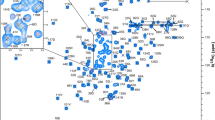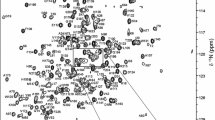Abstract
Fungal hydrophobins are secreted proteins that self-assemble at hydrophobic:hydrophilic interfaces. They are essential for a variety of processes in the fungal life cycle, including mediating interactions with surfaces and infection of hosts. The fungus Magnaporthe oryzae, the causative agent of rice blast, relies on the unique properties of hydrophobins to infect cultivated rice as well as over 50 different grass species. The hydrophobin MPG1 is highly expressed during rice blast pathogenesis and has been implicated during host infection. Here we report the backbone and sidechain assignments for the class I hydrophobin MPG1 from the rice blast fungus Magnaporthe oryzae.


Similar content being viewed by others
References
Cai M, Huang Y, Sakaguchi K, Clore GM, Gronenborn AM, Craigie R (1998) An efficient and cost-effective isotope labeling protocol for proteins expressed in Escherichia coli. J Biomol NMR 11:97–102
Catanzariti AM, Soboleva TA, Jans DA, Board PG, Baker RT (2004) An efficient system for high-level expression and easy purification of authentic recombinant proteins. Protein Sci 13:1331–1339
Goddard TD, Kneller DG. SPARKY. University of California at San Francisco. http://www.cgl.ucsf.edu/home/sparky/
Kwan AH, Winefield RD, Sunde M, Matthews JM, Haverkamp RG, Templeton MD, Mackay JP (2006) Structural basis for rodlet assembly in fungal hydrophobins. Proc Natl Acad Sci USA 103:3621–3626
Mackay JP, Matthews JM, Winefield RD, Mackay LG, Haverkamp RG, Templeton MD (2001) The hydrophobin EAS is largely unstructured in solution and functions by forming amyloid-like structures. Structure 9:83–91
Petersen TN, Brunak S, von Heijne G, Nielsen H (2011) SignalP 4.0: discriminating signal peptides from transmembrane regions. Nat Methods 8:785–786
Scholtmeijer K, Janssen MI, van Leeuwen MB, van Kooten TG, Hektor H, Wosten HA (2004) The use of hydrophobins to functionalize surfaces. Biomed Mater Eng 14:447–454
Sharma D, Rajarathnam K (2000) 13C NMR chemical shifts can predict disulfide bond formation. J Biomol NMR 18:165–171
Shen Y, Delaglio F, Cornilescu G, Bax A (2009) TALOS+: a hybrid method for predicting protein backbone torsion angles from NMR chemical shifts. J Biomol NMR 44:213–223
Skamnioti P, Gurr SJ (2009) Against the grain: safeguarding rice from rice blast disease. Trends Biotechnol 27:141–150
Sunde M, Kwan AH, Templeton MD, Beever RE, Mackay JP (2008) Structural analysis of hydrophobins. Micron 39:773–784
Talbot NJ, Kershaw MJ, Wakley GE, deVries OMH, Wessels JGH, Hamer JE (1996) MPG1 encodes a fungal hydrophobin involved in surface interactions during infection-related development of Magnaporthe grisea. Plant Cell 8:985–999
Wang X, Permentier HP, Rink R, Kruijtzer JAW, Liskamp RMJ, Wosten HAB, Poolman B, Robillard GT (2004) Probing the self-assembly and the accompanying structural changes of hydrophobin SC3 on a hydrophobic surface by mass spectrometry. Biophys J 87:1919–1928
Acknowledgments
This work was supported by an Australian Research Council Discovery Project (DP0879121). MS was supported by a NHMRC RD Wright Career Development Fellowship.
Conflict of interest
The authors declare that they have no conflict of interest.
Author information
Authors and Affiliations
Corresponding author
Rights and permissions
About this article
Cite this article
Rey, A.A., Hocher, A., Kwan, A.H. et al. Backbone and sidechain 1H, 13C and 15N chemical shift assignments of the hydrophobin MPG1 from the rice blast fungus Magnaporthe oryzae . Biomol NMR Assign 7, 109–112 (2013). https://doi.org/10.1007/s12104-012-9394-x
Received:
Accepted:
Published:
Issue Date:
DOI: https://doi.org/10.1007/s12104-012-9394-x




